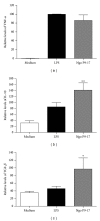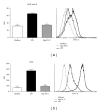Neisseria gonorrhoeae induces a tolerogenic phenotype in macrophages to modulate host immunity
- PMID: 24204097
- PMCID: PMC3800590
- DOI: 10.1155/2013/127017
Neisseria gonorrhoeae induces a tolerogenic phenotype in macrophages to modulate host immunity
Abstract
Neisseria gonorrhoeae is the etiological agent of gonorrhoea, which is a sexually transmitted disease widespread throughout the world. N. gonorrhoeae does not improve immune response in patients with reinfection, suggesting that gonococcus displays several mechanisms to evade immune response and survive in the host. N. gonorrhoeae is able to suppress the protective immune response at different levels, such as B and T lymphocytes and dendritic cells. In this study, we determined whether N. gonorrhoeae directly conditions the phenotype of RAW 264.7 murine macrophage cell line and its response. We established that gonococcus was effectively phagocytosed by the RAW 264.7 cells and upregulates production of immunoregulatory cytokines (IL-10 and TGF- β 1) but not the production of proinflammatory cytokine TNF- α , indicating that gonococcus induces a shift towards anti-inflammatory cytokine production. Moreover, N. gonorrhoeae did not induce significant upregulation of costimulatory CD86 and MHC class II molecules. We also showed that N. gonorrhoeae infected macrophage cell line fails to elicit proliferative CD4+ response. This implies that macrophage that can phagocytose gonococcus do not display proper antigen-presenting functions. These results indicate that N. gonorrhoeae induces a tolerogenic phenotype in antigen-presenting cells, which seems to be one of the mechanisms to induce evasion of immune response.
Figures




References
-
- Farley TA, Cohen DA, Elkins W. Asymptomatic sexually transmitted diseases: the case for screening. Preventive Medicine. 2003;36(4):502–509. - PubMed
-
- Handsfield HH, Lipman TO, Harnisch JP, Tronca E, Holmes KK. Asymptomatic gonorrhea in men: diagnosis, natural course, prevalence and significance. The New England Journal of Medicine. 1974;290(3):117–123. - PubMed
Publication types
MeSH terms
Substances
LinkOut - more resources
Full Text Sources
Other Literature Sources
Research Materials

